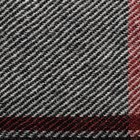
Photodisc/Photodisc/Getty Images
Wool sweaters require a different approach to cleaning than cotton alternatives. Wool fibers are very easy to stretch, deform and shrink, potentially making the garment unwearable. By using the proper methods, detergents and water temperature, you can be sure your wool sweaters remain fresh and well-fitted for many years to come.
Hand Washing
Avoiding a washing machine entirely when cleaning wool sweaters is advisable. Even if you use cold water -- which won't shrink the sweater -- washing machines still play rough with clothes to get the job done. Using a bit of mild or baby shampoo with cold water in a clean sink gets the fibers clean. Follow up with a rinse under cool or tepid water to remove the soap, then dry it on a drying rack or clean white towel after reshaping the sweater.
Cashmere Is Wool Too
Cashmere sweaters are treated slightly differently than "conventional" wool sweaters. Cashmere knits may be washed in cool water by hand -- but woven cashmere should be dry cleaned only, suggests The Cashmere and Camel Hair Manufacturers Institute. To get out the excess moisture, a knit cashmere sweater may be pressed flat between two clean towels, then placed atop a drying rack to finish. Cashmere should never be twisted or rung out, as this can permanently deform the fibers.
Avoiding Water Entirely
If you're not sure about cleaning your sweaters -- even in cold water -- take it to a dry cleaner. This is a good idea anyway if the sweater has a stain, since attempting to scrub it out will probably cause the affected material to pill, stretch or thin out. Dry cleaning is also superior when it comes to maintaining the original feel and texture of wool -- but make sure you point out stains and areas of special focus when you drop the item off.
Between Uses
Wool sweaters don't need to be cleaned after every use. However, like all natural fabrics it makes sense to air them out prior to stashing them for next time. The ideal scenario is to have a ventilated place to lay the sweater flat after wearing. A drying rack works well for this. Wool sweaters should not be hung, as this will deform the garment. Folding the sweater properly and sealing it in a plastic bag keeps the moths away. Alternately, roll it to avoid creases -- but never store or fold while damp, as this fosters mold and mildew.
Related Articles

How to Hand Wash a Two-Ply Cashmere ...

Care of Mohair Fabric

How to Clean Mohair

Can Chiffon Be Washed?

Care of Satin Fabric

How to Protect Cashmere Scarves From ...

Care for Fabric Made With Viscose

What Is Polyester Crepe Fabric?

How to Wash Wool Pants

How to Restore Stiff Cotton Sweaters

How to Clean Viscose Shawls

How to Care for Merino Wool

How to Get Out Hanger Humps From a ...

Can You Hand Wash Silk That Says Dry ...

Description and Characteristics of ...

How to Get Wrinkles Out of Nylon ...

How to Wash Dupioni Silk

How to Hand Wash a Beanie

Cashmere Vs. Viscose

Cashmere Allergies
References
Writer Bio
David Lipscomb is a professional writer and public relations practitioner. Lipscomb brings more than a decade of experience in the consumer electronics and advertising industries. Lipscomb holds a degree in public relations from Webster University.
Photo Credits
Photodisc/Photodisc/Getty Images